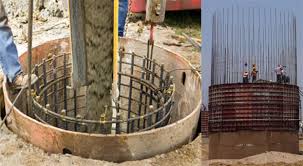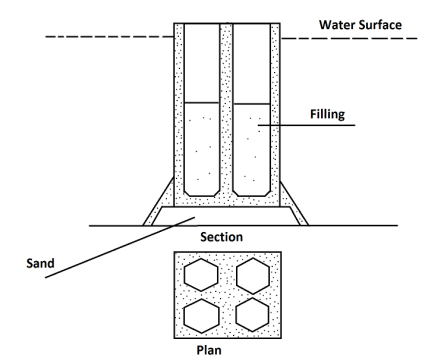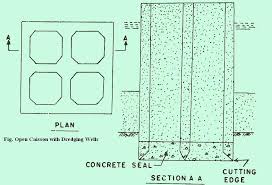Like an open caisson, a well foundation built on the dry bed or after the sand island has been built. Wells can be dug on the river bank and floated to their final location if the water velocity is high and the depth is greater than 5 to 6 meters. When grounding a well, extreme caution is used to ensure that the well is in the proper position. Sandbags are placed around the well. Due to its weight, the well may sink 500 mm to 600 mm into the river. The procedure for sinking wells on the dry bed is identical to that of the wet bed.

Fig 1: Well Foundation
Courtesy: Constructioncivil.com
A ground-level excavation through the dredge holes was necessary to bury the well. On the inside, wells are hollow, filled with sand, and plugged at the top and bottom. The load is passed to the surrounding wall or seining. Seining is usually brick, stone, or plain or reinforced concrete. The seining is properly designed to bear the imposed loads because it will become an exterior part of the well. It should also be heavy enough to overcome frictional resistance as it sinks. A sharp cutting edge makes sinking easier. The well curb refers to the tapering section of the well above the cutting edge. The load of the superstructure is transmitted to the well by a Reinforcement well cover at the top.
Types of Well Foundation:
1. Box Well Foundation
A prefabricated concrete box (with sides and a bottom) is set on ready-made foundations to form a box well foundation. It is then filled with concrete and used as part of a permanent structure,

Fig 2: Box Well Foundation
Courtesy: Civilnotepppt.com
such as the foundation of a bridge pier. Because hollow concrete structures are thinner than water, they are ballasted or anchored to keep them floating until they are filled—complex anchoring methods are required in other situations, such as tidal zones. Using adjustable anchoring devices and a GPS survey, engineers can position a box caisson with pinpoint accuracy.
Advantages of Box Well Foundation:
i) They are quite inexpensive to build.
ii) It can be used when other caissons aren’t an option.
Disadvantages of Box Well Foundation:
i) It’s difficult to provide a foundation base below the water level, especially for deep excavations.
ii). The bearing capacity of the foundation base must be thoroughly assessed. Care is taken to preserve the foundation base from scour.
2. Pneumatic Well Foundation:

Fig 3: Pneumatic Well Foundation
Courtesy: Orsc.co.jp
The internal air pressure in pneumatic caissons is kept high to prevent water from entering the closed chamber. The working space keeps dry to allow skilled professionals to work in the chamber. There are airlocks at the summit. The caisson is sunk in the working chamber under completely controlled conditions by qualified professionals and supervision employees. The working chamber was filled with concrete, and the caisson sunk after reaching the final depth.
After the reached final depth, the working chamber is filled with concrete and sunk the caisson.
Advantages of Pneumatic Well Foundation:
i) The caisson’s sinking is perfectly controlled, allowing staff in the working chamber to promptly detect tilts and shifts and take appropriate corrective action.
ii) The compartment’s bottom is effectively sealed since it is dry.
iii) Boulders and other obstacles to sinking are simply eliminated.
Disadvantages of Pneumatic Well Foundation:
i) Workers in the working chamber can quickly notice tilts and shifts and take necessary corrective action because the caisson’s sinking is perfectly regulated.
ii) Because the compartment’s bottom is kept dry, it is sealed.
iii) Boulders and other sinking obstructions were removed.
3. Open Well Foundation:

Fig 4: Open Well Foundation
Courtesy: Theconstructioncivil.org
During construction, open well foundations, also known as caissons, have an open top and bottom. An open caisson’s plan might be circular, rectangular, or elliptical. It features a cutting edge at the bottom, which is made on-site, just as the initial half of the shaft. The soil inside the shaft is dredged using proper equipment when the well sinks by self-weight, allowing the well to sink further into the ground. The next part of the shaft is then added to it. The self-weight sinking and dredging procedure is repeated until the desired depth is obtained. Below is the scour level of employment. The bottom of the well is cemented with concrete, which also serves as the well’s foundation. The hollow shaft is filled with sand, and a top plug, also known as a concrete seal, is placed on top. Open caissons can be built to any depth and are quite cheap to build. The maximum depth to which the caisson can be sunk is determined by the caisson’s loads, the soil’s carrying capacity, and the sides’ skin friction resistance. Below are the scour level and the minimum grip length to be used.
Advantages of Open Well Foundation:
i) The caisson has the capability of being erected to a great depth.
ii) The construction cost is less than for other types of caissons.
Disadvantages of Open Well Foundation:
i) Construction in boulder deposits progresses more slowly.
ii) Concrete that has been water-sealed is rendered ineffective.
iii) There is no means to look at the bottom of the well.
Conclusion:
Well, foundations are used to support heavy structures like bridge piers and abutments. A well foundation is a deep foundation used in a specific context. Other constructions, such as bridges, docks, and piers below, are built on well foundations below the water level.
References:
1. Pvt. Ltd., N. M. (2010, September 1). Well, Foundations for Bridges Are Obsolete!!!. Well, Foundations for Bridges are Obsolete!!!. https://www.nbmcw.com/article-report/infrastructure-construction/bridges/well-foundations-for-bridges-are-obsolete.html.
2. Well Foundation: Types, Advantages & Disadvantages. (2020, September 30). Constructionor.Com. https://constructionor.com/well-foundation/.
3. Well, Foundation And There Parts And Shapes – Civil Knowledge. (2019, September 22). Civil Knowledge. https://www.civilknowledges.com/well-foundation/.
4. Well Foundation: Meaning, Advantages, Types, Components & Diagram – Cement Concrete. (2021, October 30). Cement Concrete. https://cementconcrete.org/structural/foundation-design/well-foundation/3320/.
If you have a query, you can ask a question here.


